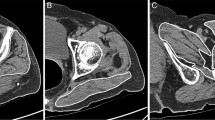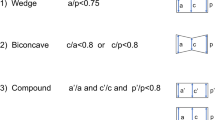Abstract
Purpose
A correlation between soft tissue thickness and osteoporosis has been suggested. We aimed to estimate if a low body mass index (BMI) and/or a decrease of skin thickness could estimate the risk of contra-lateral hip fracture.
Methods
First, we performed a retrospective analysis of 1268 patients treated for a hip fracture. The 146 patients who had a contra-lateral hip fractures—study group—were compared with the 1078 patients who did not—control group. Four BMI categories were considered: obese, overweight, normal weight and low weight. Second, we enrolled prospectively 1000 consecutive patients in the emergency department. History of fractures, BMI, and skin aspect on the dorsum of both hands—classified as severe decrease thickness, moderate decrease thickness or normal—were recorded.
Results
pt?>In the first part, we found that patients with contra-lateral fractures had a significantly lower BMI than those in the control group (22.2 Vs 26.5 kg/m2, p = 0.01). In the second part, 48 on 1000 patients had a hip fracture. Among them, six had a contra-lateral fracture. BMI was 23.4 kg/m2 in bilateral hip fractures, 33.68 kg/m2 in the unilateral fracture group, and 28.04 kg/m2 in the non-fracture group (p = 0.04). Finally, patients with contra-lateral hip fractures had a severe decrease thickness of the skin.
Conclusion
A low BMI and a decreased skin thickness increase independently the risk of fractures by three times. When associated, they increase the risk of fracture risk by five times. This combination had a sensitivity at 71 % and a specificity at 90 % for predicting hip fracture.



Similar content being viewed by others
References
Müller F, Galler M, Zellner M et al (2015) The fate of proximal femoral fractures in the 10th decade of life: an analysis of 117 consecutive patients. Injury 46:1983–1987. doi:10.1016/j.injury.2015.06.048
Skála-Rosenbaum J, Džupa V, Bartoška R et al (2015) Subsequent contralateral hip fractures: can at-risk patients be identified? An observational study of 5,102 patients. Int Orthop 39:755–760. doi:10.1007/s00264-014-2646-x
Burgers PTPW, Zielinski SM, Mailuhu AKE et al (2014) Cumulative incidence and treatment of non-simultaneous bilateral femoral neck fractures in a cohort of one thousand two hundred and fifty patients. Int Orthop 38:2335–2342. doi:10.1007/s00264-014-2447-2
Kok LM, van der Steenhoven TJ, Nelissen RGHH (2010) A retrospective analysis of bilateral fractures over sixteen years: localisation and variation in treatment of second hip fractures. Int Orthop 35:1545–1551. doi:10.1007/s00264-010-1176-4
Dinah AF (2002) Sequential hip fractures in elderly patients. Injury 33:393–394
Schrøder HM, Petersen KK, Erlandsen M (1993) Occurrence and incidence of the second hip fracture. Clin Orthop Relat Res 166–169
Hooven FH, Adachi JD, Adami S et al (2009) The global longitudinal study of osteoporosis in women (GLOW): rationale and study design. Osteoporos Int 20:1107–1116. doi:10.1007/s00198-009-0958-2
Michelotti J, Clark J (1999) Femoral neck length and hip fracture risk. J Bone Miner Res 14:1714–1720. doi:10.1359/jbmr.1999.14.10.1714
Giannini S, Luciani D, Chiarello E et al (2011) Osteosynthetic improvement of osteoporotic bone: prevention surgery. Clin Case Miner Bone Metab 8:51–54
Whitmore SE, Levine MA (1998) Risk factors for reduced skin thickness and bone density: possible clues regarding pathophysiology, prevention, and treatment. J Am Acad Dermatol 38:248–255. doi:10.1016/S0190-9622(98)70600-0
Yoneda Pde P, Biancolin SE, Gomes MSM, Miot HA (2011) Association between skin thickness and bone density in adult women. An Bras Dermatol 86:878–884. doi:10.1590/S0365-05962011000500003
Cagle PE, Dyson M, Gajewski B, Lukert B (2007) Can dermal thickness measured by ultrasound biomicroscopy assist in determining osteoporosis risk? Skin Res Technol 13:95–100. doi:10.1111/j.1600-0846.2007.00198.x
Patel R, Blake GM, Fogelman I (2007) Evaluation of osteoporosis using skin thickness measurements. Calcif Tissue Int 81:442–449. doi:10.1007/s00223-007-9081-6
Piérard GE, Piérard-Franchimont C, Vanderplaetsen S et al (2001) Relationship between bone mass density and tensile strength of the skin in women. Eur J Clin Investig 31:731–735
ORME SM, BELCHETZ PE (1994) Is a low skinfold thickness an indicator of osteoporosis. Clin Endocrinol 41:283–287. doi:10.1111/j.1365-2265.1994.tb02546.x
Chappard D, Alexandre C, Robert JM, Riffat G (1991) Relationships between bone and skin atrophies during aging. Acta Anat (Basel) 141:239–244
Brincat M, Kabalan S, STUDD JWW et al (1987) A study of the decrease of skin collagen content, skin thickness, and bone mass in the postmenopausal woman. Obstet Gynecol 70:840
Kanis JA, Johansson H, Oden A, McCloskey EV (2011) Guidance for the adjustment of FRAX according to the dose of glucocorticoids. Osteoporos Int 22:809–816. doi:10.1007/s00198-010-1524-7
Kim YM, Kim SH, Kim S et al (2016) Variations in fat mass contribution to bone mineral density by gender, age, and body mass index: the Korea National Health and Nutrition Examination Survey (KNHANES) 2008–2011. Osteoporos Int 27:2543–2554. doi:10.1007/s00198-016-3566-y
Tang X, Liu G, Kang J et al (2013) Obesity and risk of hip fracture in adults: a meta-analysis of prospective cohort studies. PLoS ONE 8:e55077. doi:10.1371/journal.pone.0055077
Bouxsein ML, Szulc P, Munoz F et al (2007) Contribution of trochanteric soft tissues to fall force estimates, the factor of risk, and prediction of hip fracture risk. J Bone Miner Res 22:825–831. doi:10.1359/jbmr.070309
Black MM, Bottoms E, Shuster S (1971) Skin collagen and thickness in simple obesity. Br Med J 4:149–150
Acknowledgments
The authors would like to thank Pr Philippe Hernigou for his constant help and support during the conduction of this study.
Author information
Authors and Affiliations
Corresponding author
Ethics declarations
Conflict of interest
The authors declare that they have no conflict of interest.
Rights and permissions
About this article
Cite this article
Aurégan, JC., Frison, A., Bégué, T. et al. Contra-lateral hip fracture in the elderly: are decreased body mass index and skin thickness predictive factors?. International Orthopaedics (SICOT) 41, 247–252 (2017). https://doi.org/10.1007/s00264-016-3264-6
Received:
Accepted:
Published:
Issue Date:
DOI: https://doi.org/10.1007/s00264-016-3264-6




